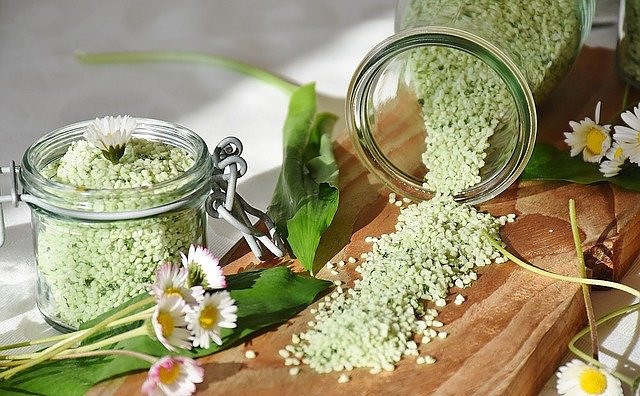In this article, we will be discussing salts, particularly a type of salt which has become popular in recent years, but with many misconceptions. That is none other than Chinen salt popular among diabetics, and many others with numerous health challenges. Some say, Chinen salt is the same as Himalayan Rock Salt, and some say it is not but Berberine. But, Is Chinen Salt the Same as Berberine? If not, what exactly is Chinen salt? Would they really help body pains? What about nerve pain in diabetes?
This article is all about answering questions.
Let’s start rolling by defining what we mean by salt.
What is Salt?
Simply named sodium chloride (NaCl) by chemists, salt is far more than the white granular seasoning found on our dining tables. Also, known as the “timeless ingredient, ” salt has played an integral role in human civilizations dating back as far as 6050BC.
The ancient civilizations traded salt as a valuable commodity, sometimes in exchange for slaves giving rise to the popular saying of “not worth his salt”.
Throughout history, salt was used in many religious offerings, symbolizing purity, and was also referred to in the Bible as “salt of the Earth.”
Salt has been the cause of bitter warfare, contributing to the French Revolution as a result of salt taxes, and determined the economy of some cultures such as Venice in Continental Europe that rose to economic greatness through its salt trade.
One of the world’s oldest known method of food preservation is salting. Salting, when properly done, ensures there is no bacterial growth that can lead spoilage in the food substance, thereby preserving it for a long time.
Although required only in small quantities, salt is an essential part of the diet of not just human, and animals, it is also essential for plants. A diet deficient in salt over a long period can result in serious health problems.
There are many types of salts, some such as the Himalayan salt, table salt, kosher salt, smoked salt, sea salt, chinen salt, etc.
Tip: There are many types of Sea Salts. For example, Celtic Sea Salt and Dead Sea Salt.
What is Berberine?
Berberine is an ammonium salt compound extracted from plants Berberis vulgaris (barberry). It is also found in other plants, such as the tree turmeric, goldenseal oregon grape, and the Chinese goldthread, in the roots, rhizomes, stems, and bark.
The plant which is commonly used as a fabric dye because of the extract which has a yellow colors, is also regarded as one of the most effective natural supplements, which is as effective as a pharmaceutical drug.
Berberine has been used for thousands of years in many cultures, for example, the Chinese used it as an antibacterial for gastrointestinal infections, and it was also used for the treatment diarrhea caused by cholera.
The Berberine salt may also contain properties that help to regulate blood sugar levels, hence its popularity, and use for the treatment, and management of type 2 diabetes mellitus.
Many other health benefits of Berberine salt are:
- Treatment of burns
- Canker sores
- High blood pressure
- Cholesterol levels in the body.
- Weight loss for obesity
- Reduce the risk of heart diseases
- Reduce the growth of cancerous cells
- Help to fight depression
- A potent anti-inflammatory, and antioxidant properties.
- Antibacterial effects
- Treatment for polycystic ovary syndrome
The safety of using berberine, however, is very doubtful especially in pregnant women, and children due to its potential for adverse drug interactions, and non-availability of high-quality research on its safety.
Berberine is extracted in many plants native to China. Some of the plants include goldenseal (Hydrastis Canadensis), Oregon grape (Berberis aquifolium), tree turmeric (Berberis aristata), and Chinese goldthread (Coptis Chinensis), among many others. Out of all, Chinese goldthread or Coptis Chinensis is commonly ‘confused’ as Chinen salt, so let’s dig further into that.
What is Coptis Chinensis?
Coptis Chinensis popularly known as the Chinese gold thread is a flowering plant native to China, and commonly used in “Traditional Chinese Medicine (TCM)”. This plant is one of the fundamental Chinese medicine herbs, referred to as Huang Lian, and contains isoquinoline alkaloids compounds including a salt Berberine.
Berberine has strong anti-inflammatory, and antibacterial properties and its numerous health benefits are why it is popularly used as supplements, tinctures, extracts, dried leaves, and roots. Berberine also has a strong, and bright yellow coloring dye and has been used traditionally to dye fabric.
Among traditional practitioners, Coptis Chinesis is used for its properties in the treatment, and management of various health conditions, such as
- Otitis Media (ear infections)
- Hypertension
- Acute gastroenteritis
- Dysentery
- Osteomyelitis
- Tuberculosis
- Liver disease
- Cancer.
Side Effects of Coptis Chinensis
Several studies have shown that the use of Coptis Chinensis causes an increase in the production of Bilirubin in the body.
Bilirubin is a naturally occurring compound, and may most likely not cause any harm, but can result in brain damage in developing fetuses, and newborn babies, hence why the beneficial plant (Coptis chinensis) is not advised for use in pregnant women, in breastfeeding mothers, and children.
Although the compound Berberine contained in the herb Coptis Chinensis help in lowering blood glucose level, its use should be closely monitored, especially when used with other diabetes drug e.g metformin to avoid complications resulting from an alarming drop in blood glucose level. (I have discussed that more in detail below)
There are no clear guidelines in the use of the herbal supplement, and therefore should be strictly recommended by your physician.
What is Berberine HCL?
Berberine hydrochloride (HCL) is the product name of the isoquinoline alkaloid compound Berberine. The product is readily available as tablets and used as supplements orally.
After ingestion, berberine HCl travels to the blood cells via the bloodstream, where it binds to different “molecular targets” in the cells, changing their functions.
When used as a supplement in the management of diabetes, berberine HCl activates an enzyme inside the body cells called “AMP-activated protein kinase”(AMPK). This enzyme is also called the “metabolic master switch, ” and plays a major role in regulating metabolism in the brain, muscles, kidney, liver, and the heart.
Its use also helps to lower the risk of heart problems by improving, and lowering blood lipids, and cholesterol, which may clog around the heart.
So, What is Chinen Salt Then?
Unlike most types of salts that come from mines, Chinen salt is a class of alkaloid salts extracted from plants such as barberry, tree turmeric, and gold thread to give the product salt Berberine.
The plants can be found in the Middle East, Asia, Europe, and North Africa.
The salt which has been used for thousands of years in Traditional Chinese Medicine (TCM), contains sodium chloride, monosodium glutamate (MSG), sodium nitrate, and iron which gives it a distinct off-white to pink coloration.
Although no clear clinical studies on the salt are available, it has been claimed that the salt contains properties that counter the toxins in the body, and helps to fight diabetes.
Chinen salt has powerful antihistamines, and helps to control the heartbeats, thereby reducing high blood pressure. The consumption of Chinen salts also assists digestion, helps to prevent muscle cramps, and helps to regulate the vascular system, catalyze bodily functions, and prevent ear infections.
Chinen Salt Vs Berberine Salt – Is Chinen Salt The Same as Berberine?
Basically, Chinen salt is the same as Berberine HCL, an alkaloid found in plants native to Europe, Asia, North Africa, and the Middle East. The salt is a combination of table salt (NaCl), and potassium nitrate (KNO3).
Tip: Don’t forget, some people believe Chinen salt is the same as Rock salt or Himalayan Salt. But, that cannot be.
What is Himalayan Salt Then?
Himalayan salt, is the widely popular salt with a pinkish tint due to its mineral impurities mined from the Punjab region of Pakistan.
Himalayan salt is used for cooking, spa treatment, or decorative lamps, people who use Himalayan salt, boasts of numerous health benefits associated with the salt, but there are no scientific backings for that.
Chemically, Himalayan salt is similar to table salt, containing 96%- 99% sodium chloride, and is also touted to contain 84 different trace mineral elements such as magnesium, sulfate, iron, zinc, and chromium, but lacks the beneficial, important iodine element found in table salts. However, unlike table salt that is highly refined, and contains anti-caking agents such as sodium aluminosilicate to prevent clumping, Himalayan salt provides a more natural option and contains no artificial substance and no additives.
Therefore, compared with refined salts such as Table Salt, the Himalayan Rock Salt is definitely a healthier option.
Uses of Pink Himalayan Salt
1. Cooking
The pink salt slab is sometimes used as a cooking surface, transferring the flavor to the meal.
2. For Healthy Skin
Himalayan salt is used in spas, and baths to relieve sore muscles, and improve the condition of the skin.
3. Salt Lamps
Salt lamps made of the Himalayan salt gives an orange-ish to pinkish glow, and it is said to remove air pollutants.
Other health benefits include;
- Balances the body pH
- Reduces the wrinkle lines around the eyes.
- Makes sleeping better
- Regulate the blood glucose level.
4. Stress buster
Himalayan salt inhalers are considered as a stress reliever.
Is Berberine Salt the Same As Himalayan Salt?
Oftentimes, Berberine salt and Himalayan salt are confused for each other because of their peculiar pink coloration, but the two salts asides from the names, vary in numerous ways which include:
- Source
The berberine salt is an alkaloid derivative from the barberry plant also known as the golden thread.
In contrast, the Himalayan pink salt is found plentiful in the salt mines of the Himalayan region of the Punjab region of Pakistan.
- Mineral Content
Berberine salt or Chinen salt contains sodium nitrate, sodium chloride, monosodium glutamate (MSG), and iron, giving it a distinct pink color.
In contrast, the Himalayan salt contains 97%-99% of sodium chloride, sodium carbonate, and about 84 trace mineral elements such as chromium, sulfate, iron, zinc, molybdenum and so on.
- Studies and Researches
Several studies in recent years have shown berberine salt contains a cellular enzyme “AMP Protein Kinase (AMPK)” that helps to regulate body metabolism in organs such as brain, kidney, liver and heart, and also shown to be as effective the widely known pharmaceutical drug Metformin used for the treatment of prediabtes, and the type 2 diabetes mellitus.
Himalayan salt, in contrast, has no known proven health benefits though it is rumored to help with weight loss, and is used in spas, and baths.
Effects of Salts On Body Pain
Salt is an important, and essential mineral element in our diets, and although required in very small quantities is a major source of electrolyte in the body. There are many varieties of salt to choose from including table salt, sea salts, pink Himalayan salt, kosher salt, varying in taste, texture, and color.
The function of salt in the body includes
- Fluid balance
- Muscle function
- Nervous transmission
- Helps thyroid function
- Regulate blood pressure
Deficiency of salt in the body can result in various health conditions, including goiter, lethargy, confusion, dizziness, fatigue, and so on. However, having too much salt in the body, can also result in various health challenges such as; heart problems.
Salt and Heart Problems
The fast-paced modernized world we live in, makes it easy for our diets to almost be dependent on fast, and easy foods. These fast foods such as salty fries, sausages, burgers, ham, etc. tastes good but are not totally healthy as it contains an excessive amount of salt, sometimes exceeding the daily recommendations of salt intake which is 2,300 milligrams per day, and is difficult to measure separately in food items.
When the amount of salt is not been regulated, it can result in the body, especially kidney to be unable to flush out the excess salt. Failure of the kidney to flush out the excess salt, will result in water retention in the body, increasing the blood pressure, creating an added pressure to the heart, and can result in stroke, and damage to blood vessels.
Furthermore, the failure of the kidney to excrete salt (sodium) and water, will result in the loss of calcium from bones, and teeth in compensation, leading to osteoporosis, fractures, back pains, and muscle pains.
In the brain, too much salt also causes the blood vessels to expand, resulting in painful headaches.
Excessive intake of salt can also result in bloating, which can make a person very uncomfortable, and sometimes unattractive.
Therefore, it is advisable to reduce the intake of salt to the barest minimum, avoid fast foods, snacks contains a high amount of sodium, and opt instead for vegetables, and home cooked meals especially for people that are genetically predisposed to diabetes or for those with underlying conditions such as hypertension.
What are the Effects of Salts On Diabetes?
The health risk of consuming excessive salt more than the daily requirement of 2,300 milligrams is numerous, and cannot be over-emphasized.
Although there are no direct links on salt intake, and blood glucose levels, people that are prediabetic, or diabetic are at a high risk of health complications associated with high salt intake.
Excessive intake of salt, results in fluid retention, raising the blood pressure, and thereby increases the risk of hypertension, stroke, kidney failure, stomach cancer, and also result in swelling of the limbs.
Some studies have also shown that excessive intake of salt, can result in weight gain, and can also play a part in the development of type 2 diabetes mellitus, by impacting insulin resistance.
When the sodium or salt level of the body is high, there is compensation for it by excessive thirst, requiring a large amount of water intake to balance it out, which is one of the symptoms of diabetes.
What are the Effects of Berberine On Diabetes Drugs (E.g. Metformin)?
The supplement Berberine which is extracted from the herb Coptis Chinensis, have been used for thousands of years amongst Chinese traditional medicine practitioners in the management of gastrointestinal disturbances such as diarrhea, and is also used for the treatment of prediabetes, and diabetes.
However, the first conventional drug approved for the treatment of diabetes, and prediabetes is Metformin. Metformin is effective for its ability to help with the weight loss, prevent cancer, and activate the AMP- protein kinase (AMPK) pathway, also called the metabolic master switch which is responsible for the regulation of the metabolism of glucose, fat, and protein.
As with most known drugs, the use of Metformin for the management of diabetes comes with a lot of gastrointestinal side effects such as nausea, bloating, diarrhea, gas, and so on.
The search for an alternative to Metformin, led to the study published by Dr Friedman in 2008, where he compared the effects of Metformin, and the plant extract Berberine for the treatment of type 2 diabetes mellitus. The doctor found that Berberine has similar effects on Metformin, as it also effectively controls the blood and postprandial glucose levels.
In the next part of the study, berberine was used alongside the anti-diabetic agent, Metformin, and it was established that the effect of both drugs when used together, are additive. That is, using of metformin, and berberine, effectively covered blood, and postprandial glucose levels, by decreasing insulin resistance, associated with type 2 diabetes, while minimizing the gastrointestinal side effects, and also have the added advantage of lowering the blood cholesterol levels, and boosting the immune system.
Tip: SumiFun NaturePro Diabetic Patch contains Barberine.
Effects of Salts On Blood Pressure
Excessive intake of salt (sodium) can affect the kidney, which is the major organ for fluid excretion being unable to filter out the excess salt, and water, leading to fluid retention. This unwanted fluid, in turn, increases the blood pressure, and over time can result in high blood pressure (hypertension).
If the cause is left unchecked, and hypertension worsens, this can result in stroke, kidney stones, kidney failure, heart failure, and even death.
Conclusion
Salt is an important, essential part of our daily diet. It also comes in various forms, examples which includes rock salts such as Himalayan, table salts, and plant extracted salt, such as berberine salt.
Berberine is an alkaloid compound, known for its use in Chinese medicine for gastrointestinal infections, but has also been argued to be as effective as conventional diabetes drug e.g. Metformin in the treatment, and management of prediabetes, and type 2 diabetes mellitus.












i looking for chinen salt